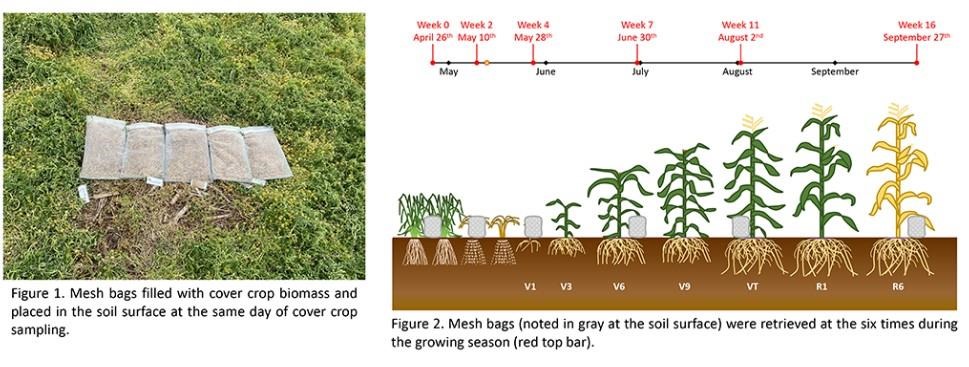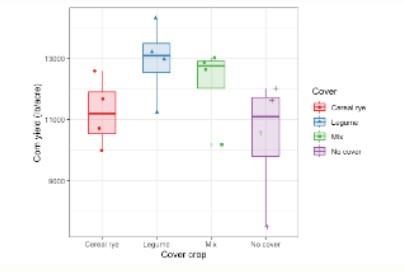By Tauana Ferreira de Almeida and Salvador Ramirez et.al
Well managed cover crops offer nutrient cycling benefits. Grass cover crop species such as cereal rye (Secale cereale L.) can scavenge nutrients such as nitrogen (N) from deeper soil layers, avoiding losses by leaching and releasing them as residues decompose. Legume cover crops, such as hairy vetch (Vicia villosa), biologically fix atmospheric N in addition to releasing N during decomposition, which can help supply the N to the subsequent cash crop. Cover crop mixtures can diversify agroecosystems and optimize the characteristics and functions of different species.
Field Management and Lab Measurements
To help us understand cover crop decomposition and N release throughout the growing season, we designed a study using “litterbags” — a common method to research crop decomposition. This research is part of the Precision Sustainable Agriculture (PSA), a collaborative project supported by the Agriculture and Food Research Initiative’s Sustainable Agricultural System Coordinated Agricultural Projects from the United States Department of Agriculture (USDA). This experiment will be repeated over three years.
Year one of the experiment was conducted in the 2020-2021 season at the Eastern Nebraska Research and Extension Center (ENREC), near Mead, Nebraska. The experimental design includes a no cover crop check and three cover crop treatments: cereal rye, hairy vetch, and a mixture of cereal rye and hairy vetch.
The cover crops were planted on Aug. 26, 2020 following oats. Cover crop aboveground biomass was collected from each cover crop treatment on April 26, 2021 using 1 m2 quadrats three days before cover crop termination on April 29, 2021 when the rye was at Feekes stage 7.0 and hairy vetch in the vegetative stage. Corn was planted on May 13, 2021, and 40 lbs of N was applied as liquid fertilizer one day before planting, and 120 lbs of N was broadcast at V4.
The samples were separated into six mesh bags, filled with equal parts of the cover crop sample. One of the mesh bags was brought to the lab and put in the dryer in the same day of the sampling (considered as “Week 0”). The other five mesh bags were placed in the field (Figure 1) and retrieved at two, four, seven, 11 and 16 weeks after the sampling day (Figure 2). Samples were dried in the lab the same day they were retrieved from the field, then subsequently weighed, ground and analyzed for C and N content by dry combustion.

Results from Year One Shows Potential for Cover Crops to Supply N to a Subsequent Corn Crop
The biomass amount produced by cereal rye, hairy vetch and mixture (cereal rye and hairy vetch), achieved an average of 5,500, 1,600 and 4,900 lbs per acre, respectively. The decomposition rate and the mass remaining at the end of the season was different for the two species (Figure 3). Hairy vetch decomposed at a greater rate than cereal rye in the first nine weeks of the season, but at the end of the season, 26% of its mass remained versus 20% of cereal rye mass. The initial C:N ratio can be the driver of the decomposition rate.

Figure 3. Percentage of mass remaining of cereal rye, hairy vetch and mixture (cereal rye and hairy vetch) throughout the 2021 corn season.
Figure 4. Percentage of nitrogen remaining from cereal rye, hairy vetch and mixture (cereal rye and hairy vetch) throughout the 2021 corn season.Table 1. C:N ratio from the residue of cereal rye, hairy vetch and mixture (cereal rye and hairy vetch) cover crops, evaluated at six times (zero, two, four, seven, 11 and 16 weeks after cover crop termination) throughout the 2021 corn season.| Date | Cereal rye | Hairy vetch | Mix |
|---|
| 4/26/21 | 21:1 | 14:1 | 18:1 |
|---|
| 5/10/21 | 22:1 | 15:1 | 20:1 |
|---|
| 5/28/21 | 23:1 | 15:1 | 18:1 |
|---|
| 6/30/21 | 19:1 | 14:1 | 16:1 |
|---|
| 8/2/21 | 15:1 | 12:1 | 13:1 |
|---|
| 9/27/21 | 12:1 | 13:1 | 13:1 |
|---|
However, not once during the six retrieval times did the cover crop residue from all three treatments achieve a C:N ratio of 25 (Table 1), the value understood to initiate nitrogen immobilization. No differences of nitrogen released by the cover crops were observed throughout the season (Figure 4). During the 16 weeks after sampling, a total of 70, 66 and 62 lb/acre of N were released by cereal rye, hairy vetch and mixture, respectively.
Corn grain yields following cover crop and no cover treatments were not significantly different. The corn yield in the 160 lb/acre N treatment had an average of 205, 235, 222 and 190 bushels per acre (11,238, 12,931, 12,174 and 10,421 lbs per acre [Figure 5]) for cereal rye, hairy vetch, mixture and no cover, respectively. We did not detect any statistical differences between yields in the four treatments but did see a numeric increase in corn after cover crops. Corn yield increased 7%, 24% and 17% after cereal rye, hairy vetch and mixture respectively, compared to corn following the no cover crop treatment.

Figure 5. Corn yield following cereal rye, hairy vetch, mixture (cereal and hairy vetch) and no cover crop treatments.
Considering strategies to supplement or offset nutrient input needs is increasingly important due to increases in N fertilizer costs. For example, the cost of anhydrous ammonia reached nearly $1,500 per ton in January 2022, representing an increase of approximately $750 per ton (ESMIS-USDA, 2022). As a top three corn-producing state, Nebraska is a large consumer of fertilizer (EPA, 2011). The results from the first year of this study demonstrate the potential of grass, legume and mixed cover crop species to recycle nutrients without negatively impacting corn yields.
This experiment will be repeated in 2022 and 2023 at new sites, following what would represent a corn-soybean-oat rotation. In the upcoming seasons, through support from the Water for Food Institute, we will monitor N uptake using in-season measurements and aerial imagery to quantify if in-season N rates might be adjusted following cover crop treatments.
Acknowledgements
The authors would like to thank the Precision Sustainable Agriculture (PSA) and Daugherty Water for Food Global Institute (DWFI) for funding support, as well as Tom Galusha, Roy Cumming and Roberta Rebesquini for their support with field research.
Source : unl.edu